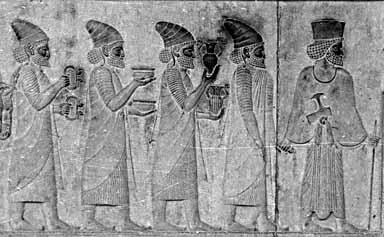|
Series:
Visual Essays
Author:
Jamshid Varza
Related Links:
Novruz in Persepolis..
Achaemenian Jewel...
Passargadae,..
The First Declaration of Human Rights... |
The
Achaemenian history as we learn mostly from Herodotus reached the peak of
its glory during the reign of Darius and his son Xerxes. It was almost one
generation after Cyrus the founder of Persian Empire had conquered the
countries spanning from India to Greece and central Asia to Africa. Cyrus
the Great with his declaration of treating all the subjects as equal members
of his empire showed unprecedented tolerance toward diversity of cultures
and religions.
Darius who built the vast central government, roads, and the organized
military could bring this empire to a new level of prosperity. Now this
empire enjoyed three capitals of Susa, Babylon, and Sardis. It was time for
Darius to build something more magnificent than all the three capitals put
together.
Darius
set out to build the new ceremonial capital of Persepolis in his homeland of
Pars -- Herodotus called it the city of Persians of Persepolis. The purpose
of the new ceremonial capital was celebration of Norooz "the beginning of spring,"
the most important of Zarathushti ceremonies. The astrological symbol of "Lion attacking
a Bull" at the entry gates symbolize the conquest of winter by spring. Darius started the
monumental project and his son Xerxes added the hall of one-hundred columns
and the famous Xerxes gates to Persepolis. Throughout Achaemenian history
every emperor added a section to this capital to make it more majestic.
The
ruins of Persepolis show the monumental work that went into building the
place. The size of gates, column and stairways with all the fine stone
carving overwhelms the visitor. At two different places in Apadana, Darius
placed two foundation plaques, one in gold, the other in silver, accompanied
with coins. The text engraved on the plaques in three languages, Old
Persian, Elamite and Babylonian, reads as follows:
"Darius, the Great
King, King of Kings, King of Countries, son of Hystaspes, the Achaemenid.
Saith Darius the King: This is the kingdom which I posses from the land of
the Sakas on this side of Sogdiana as far as Kush, from India to Sardis.
Over this Ahura Mazda has granted me dominion, he who is great above all the
Gods. May Ahura Mazda protect me and my Royal House."
Stairways
and interior stone walls of Persepolis are all covered with detailed carvings. In
many places images of people carrying objects which are headed by a Mede or
Persian nobleman can be seen. One question that usually come to visitor's
mind is "who they are and what the objects are?"
|
|
 The French archeologist, Roman Ghirshman, who
spent a good portion of his professional life working on historic sites of Iran discovered the
answer. His work set the path for scholars to follow his work and complete
his discoveries. He discovered that these men were "Tribute bearers" from
many nations under Darius' command carrying tribute to him on the day of Norooz. Each group is usually lead by a Mede or Persian nobleman. The French archeologist, Roman Ghirshman, who
spent a good portion of his professional life working on historic sites of Iran discovered the
answer. His work set the path for scholars to follow his work and complete
his discoveries. He discovered that these men were "Tribute bearers" from
many nations under Darius' command carrying tribute to him on the day of Norooz. Each group is usually lead by a Mede or Persian nobleman.
The head dress of each Tribute bearer is key to his identification
|